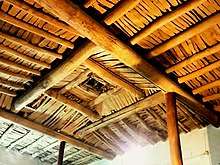Darbazi
Darbazi (Georgian: დარბაზი; from Persian: darvāze, "gate") is a term used in Georgia to describe a chamber with a distinctive "swallow dome"-type roof structure found in the traditional domestic architecture of Asia Minor and the South Caucasus. The central feature is a pyramidal vault (gvirgvini), supported on pillars and constructed of a stepped series of hewn logs and beams, with a central opening at the top which serves as a window and smoke flue. The Roman authority Vitruvius (1st century BC) includes in his De architectura a description of a Colchian dwelling, the ancient prototype of a darbazi.[1] Such lantern roofs are called harazashen or glkhatun in Armenia, kirlangiç kubbe or kirlangiç ortu in Turkey, and karadam in Azerbaijan.[2][3]
_GEORGIAN_NOBLEMAN'S_HOUSE_IN_TIFLIS.jpg)

The darbazi house, with local variations, continued to be constructed into the 20th century in Georgia. It occurs extensively in the provinces of Kartli, Kakheti, and Samtskhe-Javakheti. These houses are often supported at its underground base by finely carved beams and pillars, in particular, the solid wooden upright known as the deda-bodzi ("mother-pillar") that takes the weight of the corbelled roofing.[1] The darbazi form might have influenced the early Christian architecture of Georgia, for the ancient rotund and octagonal Christian structures—widespread in Italy, Syria, and elsewhere—never attained popularity in Georgia.[4]
Illustrations
- Darbazi in eastern Georgia (cross-section). The Great Soviet Encyclopedia. Retrieved on 2011-05-30.
- Gvirgvini. The Great Soviet Encyclopedia. Retrieved on 2011-05-30.
- Deda-Bodzi. The Great Soviet Encyclopedia. Retrieved on 2011-05-30.
References
- Lang, David Marshall (1966), The Georgians, pp. 119-123. Praeger Publishers.
- Khatchadourian, Lori (2008), Social Logics Under Empire: The Armenian 'highland Satrapy' and Achaemenid Rule, ca. 600--300 BC, p. 197. ProQuest, ISBN 0549985735.
- Karpuz, Hasim (1993), Erzurum Evleri, p66.
- Chubinashvili, Giorgi N., "On the initial forms of Christian churches", p. 195, in Mgaloblishvili, Tamila (ed., 1998), Ancient Christianity in the Caucasus. Routledge, ISBN 0-7007-0633-X.